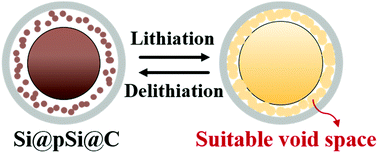Encapsulation of core–satellite silicon in carbon for rational balance of the void space and capacity†
Abstract
The void space is widely used in anode materials for relieving the volume expansion during lithium insertion and extraction processes. Generally, the void is randomly generated or exceeded the expansion to ensure the structural stability, which thus sacrifices the capacity and energy density. In this research, a core–satellite architecture was constructed with an elaborate structural design to obtain a rational balance of the void space and capacity. Such well fabricated silicon@porous silicon@carbon (Si@pSi@C) core–satellite nanoparticles with a precise void space present a satisfactory capacity of 1002 mA h g−1 over 100 cycles at a current of 100 mA g−1. This delicate core–satellite architecture could promote the use of the structural design in high-energy density lithium-ion batteries.



 Please wait while we load your content...
Please wait while we load your content...